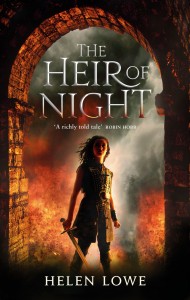Writing Epic Heroines
The Heir Of Night and The Gathering Of The Lost, the first two novels in my epic fantasy quartet, The Wall Of Night, have been recognized for the fact that the leading character, Malian, is a young woman, as well as for the number of strong and important female characters in the story.
I am really pleased that readers appreciate this aspect of the story, but I never sat down and thought: “I think I’ll write a story that’s full of strong female characters.” The story just evolved that way…
Looking below the surface, I believe it was important that I was open to the potential of the story to evolve in that way. Malian is a character who was with me for a long time before I began to write.
The vision for the character was always of a young girl, later a young woman (there’s a five year gap between the events in The Heir Of Night and those in The Gathering Of The Lost) in a (literally) dark world.
It never occurred to me that she could not be the centre of the epic events taking place, or that there was anything ground breaking or unusual in her being so. After all, there are precedents that remain some of my favourite epic fantasies, including Mara of the Acoma in Raymond E. Feist and Janny Wurts’ Empire series and Morgaine in CJ Cherryh’s series of the same name.
The difference, if difference there is, may be that the secondary characters surrounding Malian include as many female as male characters, many occupying important roles in both the story and the society. To be honest, again I never planned this: the characters simply evolved with the development of the story.
In the Wall of Night world, Malian’s people, the Derai, have a considerable number of issues: they’re militaristic, xenophobic, hidebound, and still nursing the bitter divisions of a civil war.
But there is no male/female divide (possibly because the women, in this warrior society, are physically as strong as the men.) So “of course” women will occupy the full gamut of occupations in the society, with considerable numbers in positions of authority.
Again, I did not sit down before I began writing, and think: “this is the way the society will be and operate.” Rather, as the story progressed, I realized it “just was” that way.
I also very much enjoyed the way the characters stepped forward to take their place in the tale – whether it was Asantir, the captain of the Earl of Night’s elite guard and later Commander of Night, or Jehane Mor, a herald of the mysterious Guild, or Lady Sarifa, a demonhunter from fabled Ishnapur.
Listening to the story and being open to possibility are always key to developing characters. The other key, on this ring of three, is actually focusing on writing character. The primary question I address is never, what kind of woman is this? Or, what kind of man is that?
What I ask is, what kind of personality am I dealing with? How does this particular character function within the society? What role does she or he play in the story and the world? How will she or he respond to the events that arise through the course of the book?
The answers to those questions, far more than gender, shape both who the character is, and the part she or he plays in the story.
If readers find my female characters diverse, compelling and strongly conceived, I believe it is largely because of this focus on authentic character. I am certainly pleased if I am seen as having achieved this in the Wall Of Night series.
The goal I will always strive for though, is to write human characters in all their “sorts and conditions” – so as 50% (ca.) of the human population, women are likely always going to play a big part in my storytelling. Why the heck not?










